See also:
Yusukan (Yushukwan), Kudan, c. 1910
Ex-soldiers Hall, Kudan, c. 1935
Statue of Omura Masujiro at Yasukuni Shrine, Tokyo, c. 1920.
“Yasukuni Shrine is a Shinto shrine located in Kanda, Tokyo, near to Kudanzaka. It was erected originally to commemorate the individuals who had died during the Boshin War (1867) leading to the Tokugawa overthrow and the Meiji Restoration.
“The shrine has since listed war dead from the First Sino-Japanese War (1894-1895) through to World War II, and presently lists the names, origin, birthdate and place of death of 2,466,532 men, women and children.
“The Yasukuni Honden shrine only lists the names of those who died in service of the Empire of Japan as it was created by Emperor Meiji specifically for this purpose. The Yasukuni Chinreisha shrine was created by the priesthood to commemorate those who fought in opposition to the Empire and everyone else who has had died in war.”
– Wikipedia
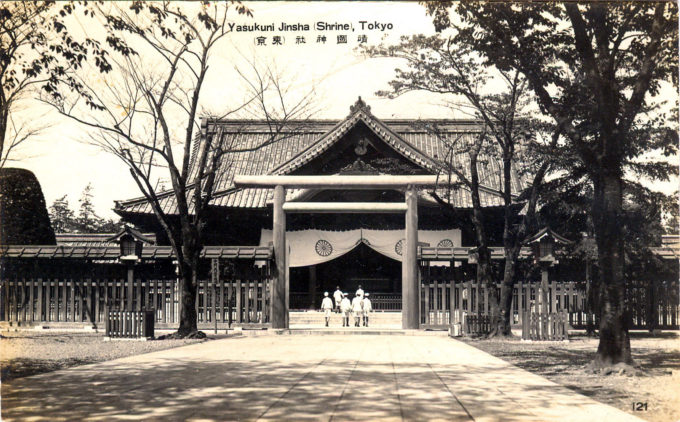
Yasukuni Shrine, Tokyo, c. 1930. At the entrance to the shrine is the Chumon torii. the last torii visitors must pass underneath before reaching Yasukuni’s haiden.
“On the top of the hill Kudan, a short way beyond the British Legation, stands the modern Shinto temple of Yasukuni, better known as Shinkosha, or Spirit-Invoking Shrine. This temple was erected in 1869 for the worship of spirits of those who had fallen fighting for the Mikado’s cause in the revolutionary war of the previous year.
“Shinkosha is built in accordance with the severest canons of pure Shinto architecture, and is completely empty except for a mirror, a drugget [rug], and a dozen cheap wooden chairs for the use of the officials who come to assist at the memorial services which are held from time to time, the principal ones being on the 6th of May and 6th November. These occasions are enlivened by horse-races, wrestling, and other amusements which draw a large concourse of spectators.
“The enormous bronze Daini torii was set up in December, 1887. The grounds behind the temple have been tastefully laid out, and look their best in early spring when the plum-trees are in blossom.”
– A Handbook for Travellers in Japan, by Basil Hall Chamberlain & W.B. Mason, 1893
- Statue of Omura Masujiro, c. 1910, founder of modern Japanese Army.
- The Daini gate, c. 1910, is the largest bronze torii in Japan, erected in 1887..
“A young officer, his uniform dyed with blood, forced out a few painful words. ‘You know … the song … of Kudanzaka?’
“‘Yes, I like it very much.’ It was a haunting song about an aged mother from the country taking her dead son’s medal to the Yasukuni Shrine in Kudanzaka. She began to sing:
From Ueno Station to Kudanzaka
I get impatient, not knowing my way around.
It has taken me all day, leaning on my cane,
To come and see you, my song, at Kudanzaka.
The great torii [gate] looming up in the sky
Leads to a magnificent shrine
That enrolls my son among the gods.
Your unworthy mother weeps for joy.
– The Rising Sun: The Decline and Fall of the Japanese Empire, 1936-1945, by John Toland, 1970
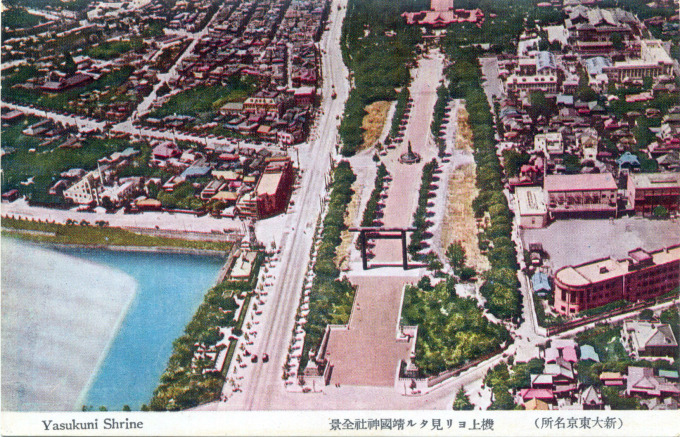
Aerial view of Yasukuni shrine grounds at Kudanzaka, Tokyo, c. 1940, depicting the Daiichi gate, Omura statue, and Yasukuni shrine.
“The shrine’s supposed religious purpose was to provide a sanctuary where the Emperor conducted rituals over the spirits of the war dead who sacrificed themselves for his honor and glory.
“Regardless of their earthly stations, soldiers enshrined at Yasukuni were apotheosized [goshi] and worshipped as kami [gods], or deities safeguarding the nation, by the Emperor himself. The ultimate sacrifice, loyalty and patriotism was thus displayed not only on the battlefield in one’s physical death, but continued after death as one’s spirit faithfully served the nation.
“In addition, the rhetoric of fidelity and the call to arms through self-sacrifice as indicated in the Rescript of 1868 became a template on which nationalism would be patterned up to the present day.”
– Yasukuni Shrine and the Constraints on the Discourses of Nationalism in Twentieth Century Japan, by Joshua Safier, 1997


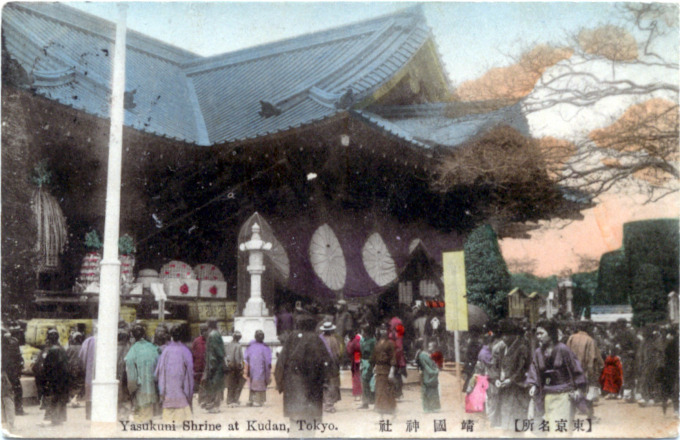
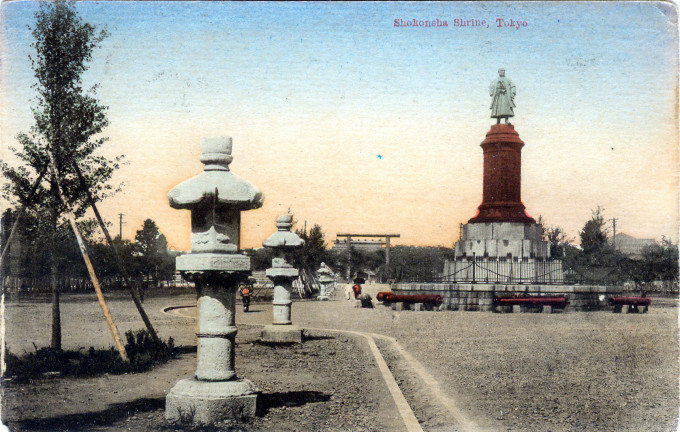
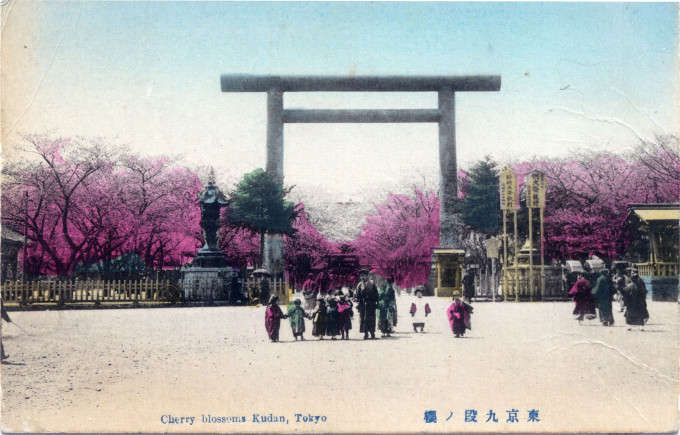
Pingback: Kundanzaka (Kudan Slope), Tokyo, c. 1910. | Old Tokyo
Pingback: Yushukan (Yushukwan), Kudan, c. 1910. | Old Tokyo
Pingback: Sophia University, Yotsuya, Tokyo, c. 1930. | Old Tokyo
Pingback: Statue of Omura Masujiro at Yasukuni Shrine, Tokyo, c. 1920. | Old Tokyo
Pingback: Ex-Soldiers Hall (Gunjin Kaikan), Kudan, Tokyo, c. 1935 | Old Tokyo
Pingback: Prince Kitashirakawa Yoshihisa | Old Tokyo
Pingback: Garden of Yasukunijinsha, Tokyo, c. 1910. | Old TokyoOld Tokyo
Pingback: “Contrivance of Yasukuni-jinja”, Tokyo, c. 1920. | Old TokyoOld Tokyo
Pingback: “Memorial to Captain Araki in Hsingan Ling”, Manchukuo, 1936. | Old TokyoOld Tokyo